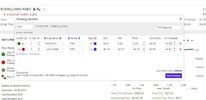Can you explain this for the idiots among us?
*Sigh* Lets see...
SPX = SPY 500 Index
RUT = Russell 2000 Index
They are literally the indexes themselves, not ETFs. Trading options on the index itself, rather than ETFs that follow the index (SPY or IWM) have distinct advantages - 60/40 long term/short term capital gains tax treatment, no early execution (european style execution), cash settlement, lower transaction costs since SPX = 10 x Spy.
Selling Put = Selling a promise/contract that you will buy something at a certain price "strike price" and on a certain date and time. For selling this promise/contract, you get paid a premium. This premium is your profit.
Cash secured put = You need 100% of the cash in your account when you say you will buy this something that you promised that you will buy
Naked put = you only need 10%-30% of the money to do a trade depending on what you're trading - you're leveraged essentially. SPX and RUT only require 10% of the money. So you're leveraged 10X in a naked put on Spx and IWM. But you can use this leverage to actually make very safe trades and still maintain excellent return.
Real numbers follow from current market prices, see attached screen shot from option chain from my etrade account (See Screenshot_57):
If you sold a $1790 (strike price) Put for RUT for expiration date Feb 26th, 2021 (1 month from today). You will receive a premium of $800 for a market order (current bid price).
This $1790 strike price is 17.5% below todays price of $2163. For a Naked put I require $17900 cash in the account (10%) and I will receive $800 of profit on this money.
So, if in the next 1 month, RUT (russell 2000 small cap index) does not drop 17.5%, then I have made $800 profit on cash deposits of $17900. This is a 4.4% return in 1 month. Rinse and repeat every month to get a similar 3-4% monthly return. Enjoy 40%+ annual return when the going is good and market doesn't crash.
If market does crash that month, no biggie, now you do a "rollover", which is when you "buy back" and close this 1 month Put that you sold (you might be paying $1600 or whatever for this put that you had originally been paid $800 for). But you sell another option that is further out (1 year for example) with a much lower strike, and essentially use the new premium to pay for the cost of "buying back" the losing option trade, and put the surplus in your pocket. Screenshot_58 shows what a rollover trade would look like. With todays number such a trade gives another $3000 in profit, and drops the cash requirements (the 10% required) to $13500 because the strike was effectively dropped to $1350 from $1790 and the time was extended to January 2022. Thus, making it unlikely to reach this new lower strike price. Rinse and repeat if needed if markets keep declining, can push time up to 3 years out, and with each time push can drop strike price by a decent amount. Essentially you're the insurance company that keeps collecting a premium against disasters - but when the disaster happens, you change the terms of the contract
😉 The big assumption here is that Russell 2000 will not go to 0 - its an index of 2000 companies, it shouldnt. If it does, we're all screwed anyway.
Now lets say 1 year from now, January 26th 2022, price of RUT is 35% below todays - $1405. If you were an index fund investor with a heavy small cap tilt your account is down 35% roughly. The $1405 price is ABOVE my $1350 strike. My option is out of the money and expires worthless. Your account is down 35%, my account is up by $3800 on the original $17300 cash - 22% up.






